Logical Fallacies
Logical fallacies are errors in reasoning that are based on poor or faulty logic. When presented in a formal argument, they can cause you to lose your credibility as a writer, so you have to be careful of them.
Sometimes, writers will purposefully use logical fallacies to make an argument seem more persuasive or valid than it really is. In fact, the examples of fallacies on the following pages might be examples you have heard or read. While using fallacies might work in some situations, it’s irresponsible as a writer, and, chances are, an academic audience will recognize the fallacy.
However, most of the time, students accidentally use logical fallacies in their arguments, so being aware of logical fallacies and understanding what they are can help you avoid them. Plus, being aware of these fallacies can help you recognize them when you are reading and looking for source material. You wouldn’t want to use a source as evidence if the author included some faulty logic.
The following pages will explain the major types of fallacies, give you examples, and help you avoid them in your arguments.
Straw Man Fallacy
A straw man fallacy occurs when someone takes another person’s argument or point, distorts it or exaggerates it in some kind of extreme way, and then attacks the extreme distortion, as if that is really the claim the first person is making.
Person 1:I think pollution from humans contributes to climate change.
Person 2:
So, you think humans are directly responsible for extreme weather, like hurricanes, and have caused the droughts in the southwestern U.S.? If that’s the case, maybe we just need to go to the southwest and perform a “rain dance.”
The comic below gives you a little insight into what this fallacy might look like. Join Captain Logic as he works to thwart the evil fallacies of Dr. Fallacy!
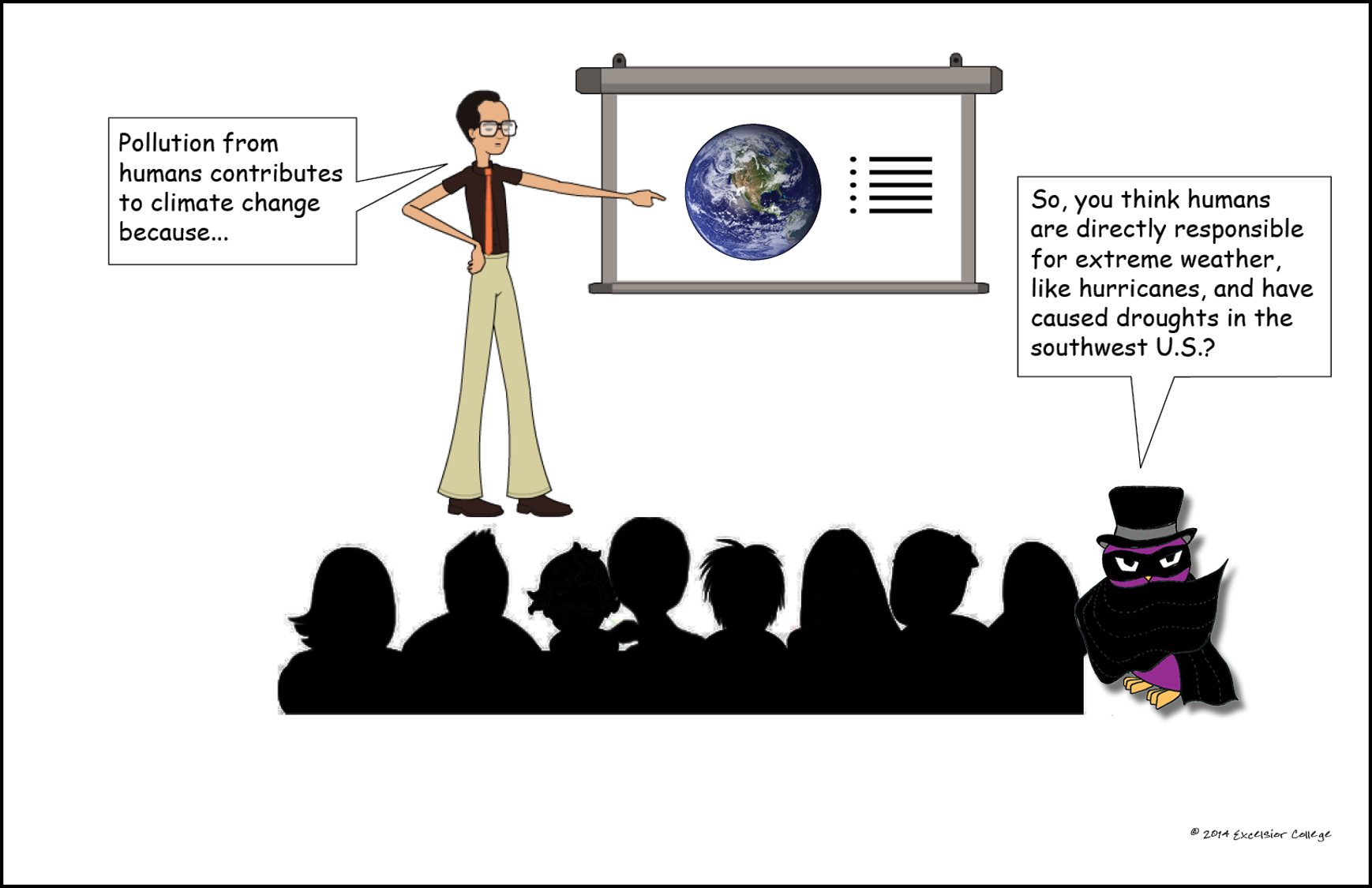
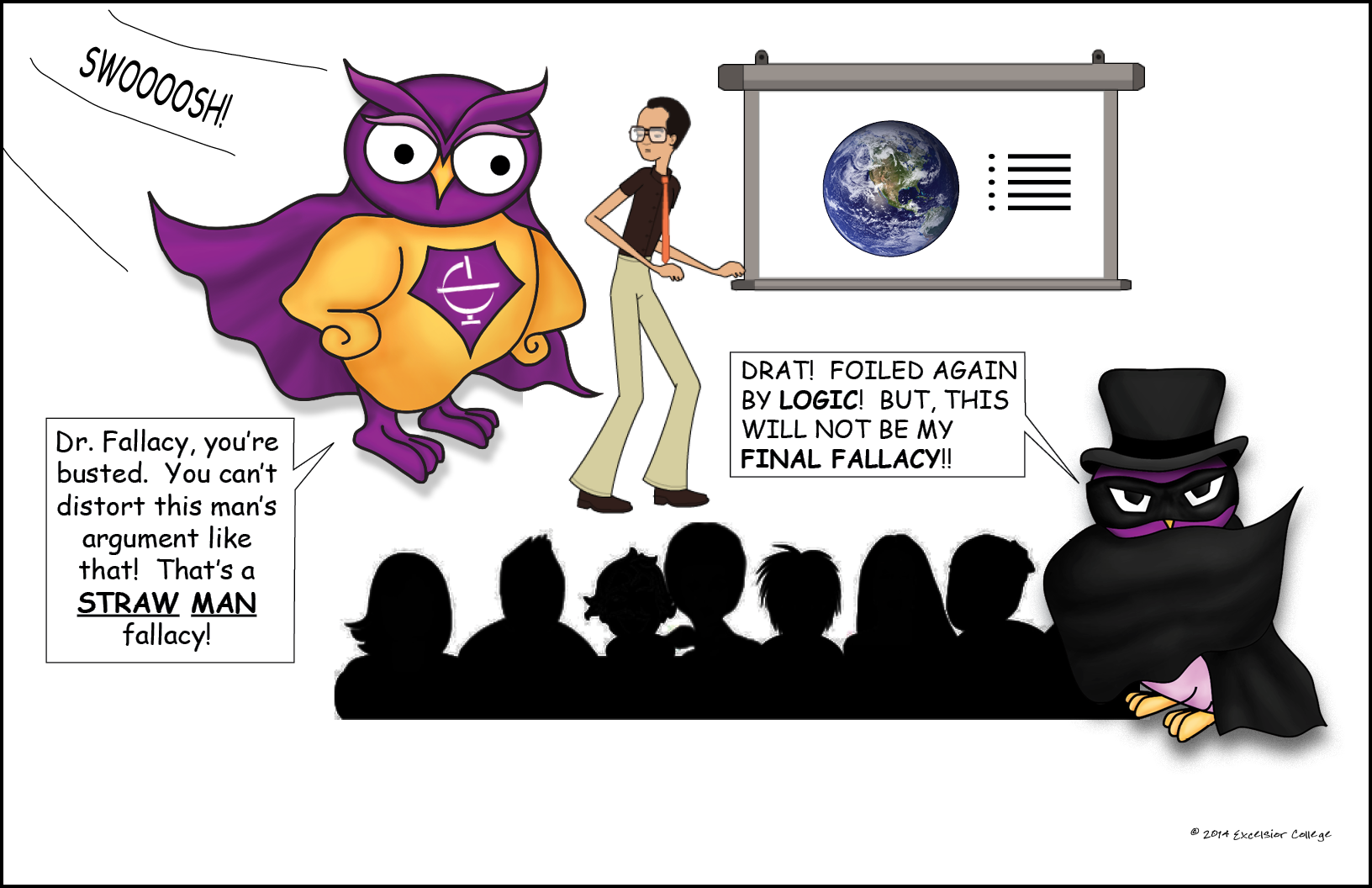
In this example, you’ll notice how Dr. Fallacy completely distorted the speaker’s point. While this is an extreme example, it’s important to be careful not to fall into this kind of fallacy on a smaller scale because it’s quite easy to do. Think about times you may have even accidentally misrepresented the other side in an argument. We have to be careful to avoid even the accidental straw man fallacy!
False Dilemma Fallacy
Sometimes called the “either-or” fallacy, a false dilemma is a logical fallacy that presents only two options or sides when there are many options or sides. Essentially, a false dilemma presents a “black and white” kind of thinking when there are actually many shades of gray.
Person 1:You’re either for the war or against the troops.
Person 2:
Actually, I do not want our troops sent into a dangerous war.
The comic below gives you a little insight into what this fallacy might look like. Observe as Captain Logic saves the day from faulty logic and the evil Dr. Fallacy!
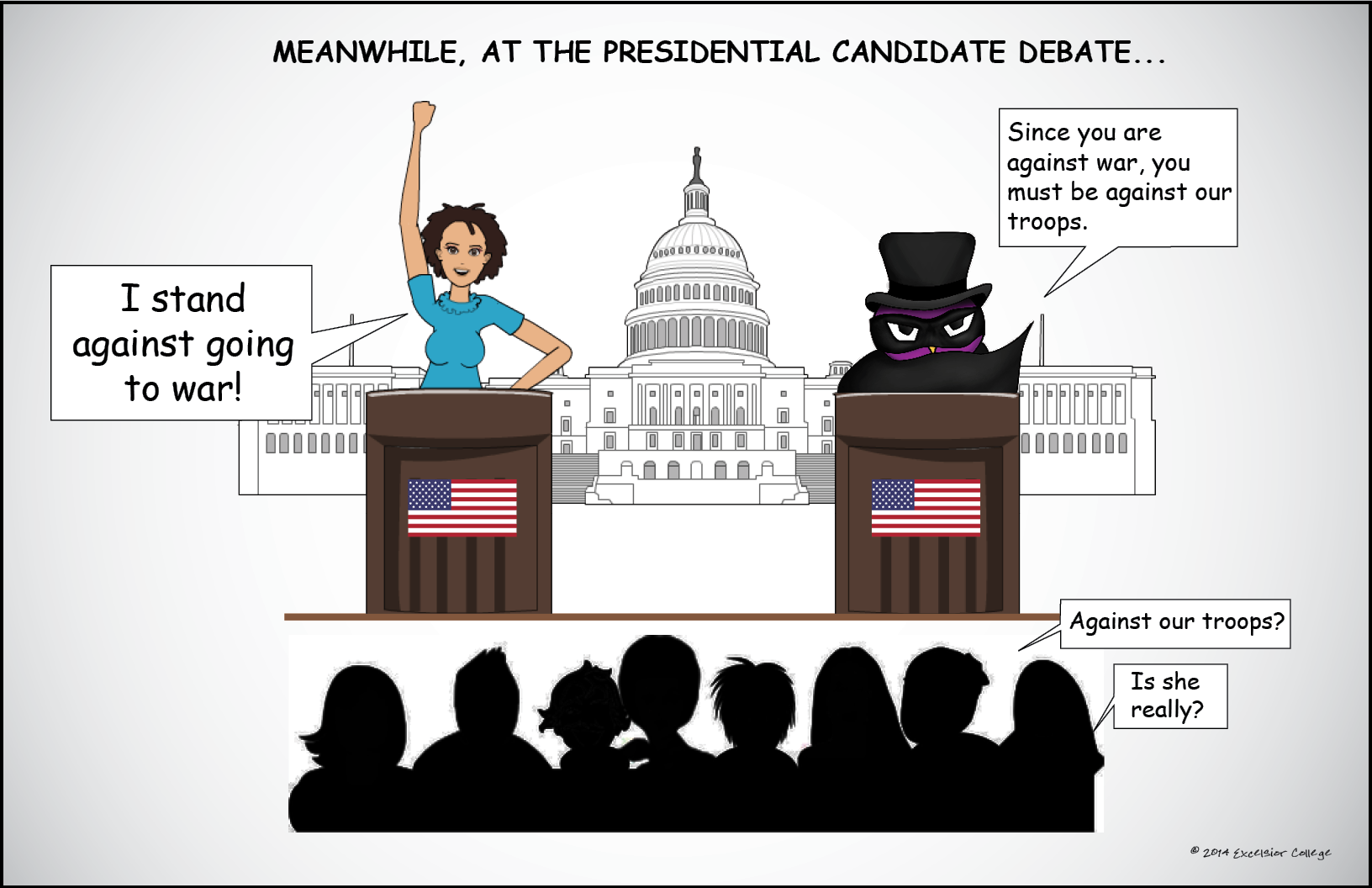
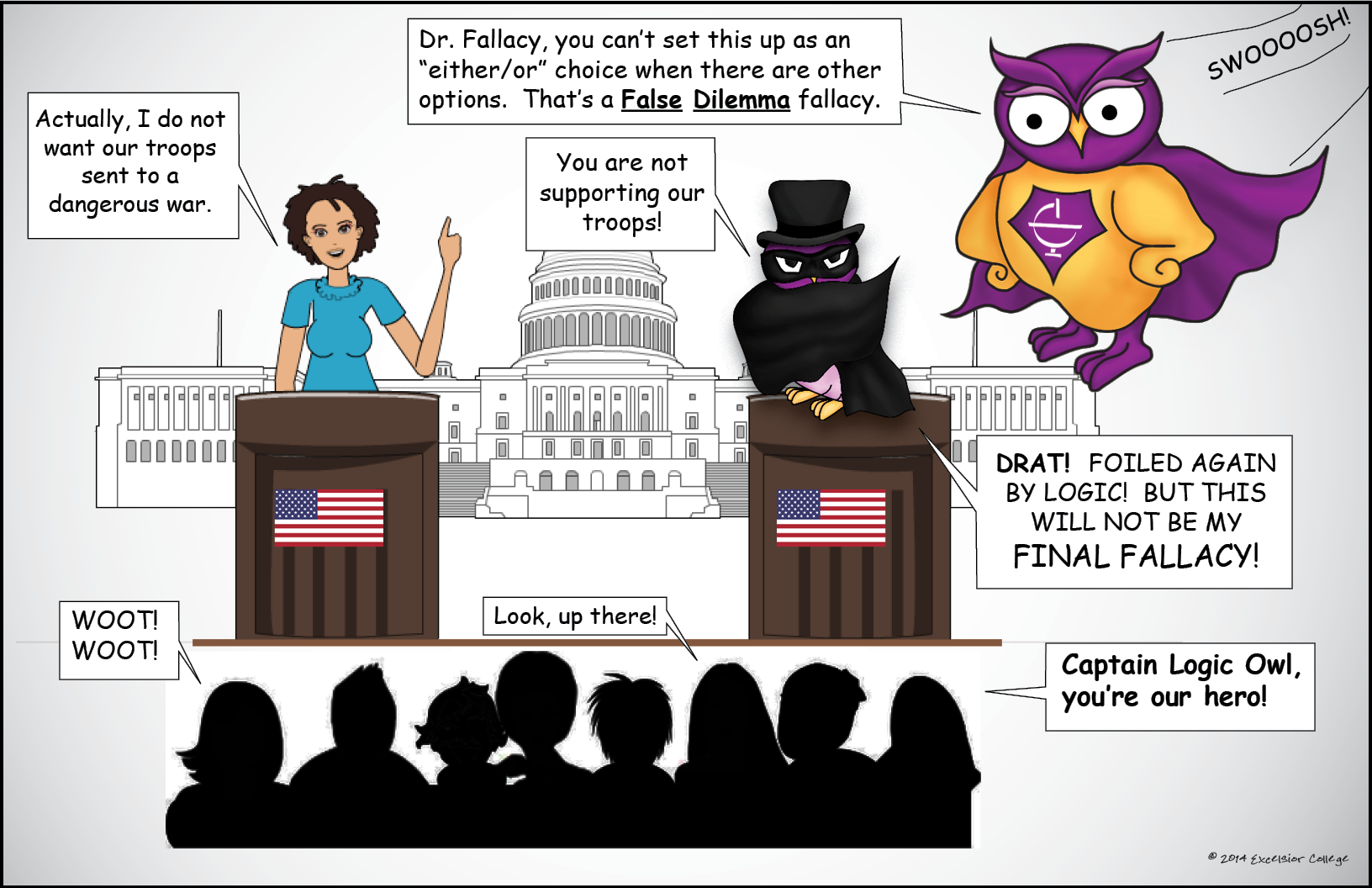
In this comic, you’ll notice that Dr. Fallacy is presenting only two options, but the first person clearly has a middle position. You have to be really careful of this kind of fallacy, as it can really turn your audience away from your position. The world is complex, and the way people think is complex. If you dismiss that, you could lose the respect and interest of your audience.
Hasty Generalization Fallacy
The hasty generalization fallacy is sometimes called the over-generalization fallacy. It is basically making a claim based on evidence that it just too small. Essentially, you can’t make a claim and say that something is true if you have only an example or two as evidence.
Example:Some teenagers in our community recently vandalized the park downtown. Teenagers are so irresponsible and destructive.
You can see Dr. Fallacy in action with this type of fallacy in the comic below.
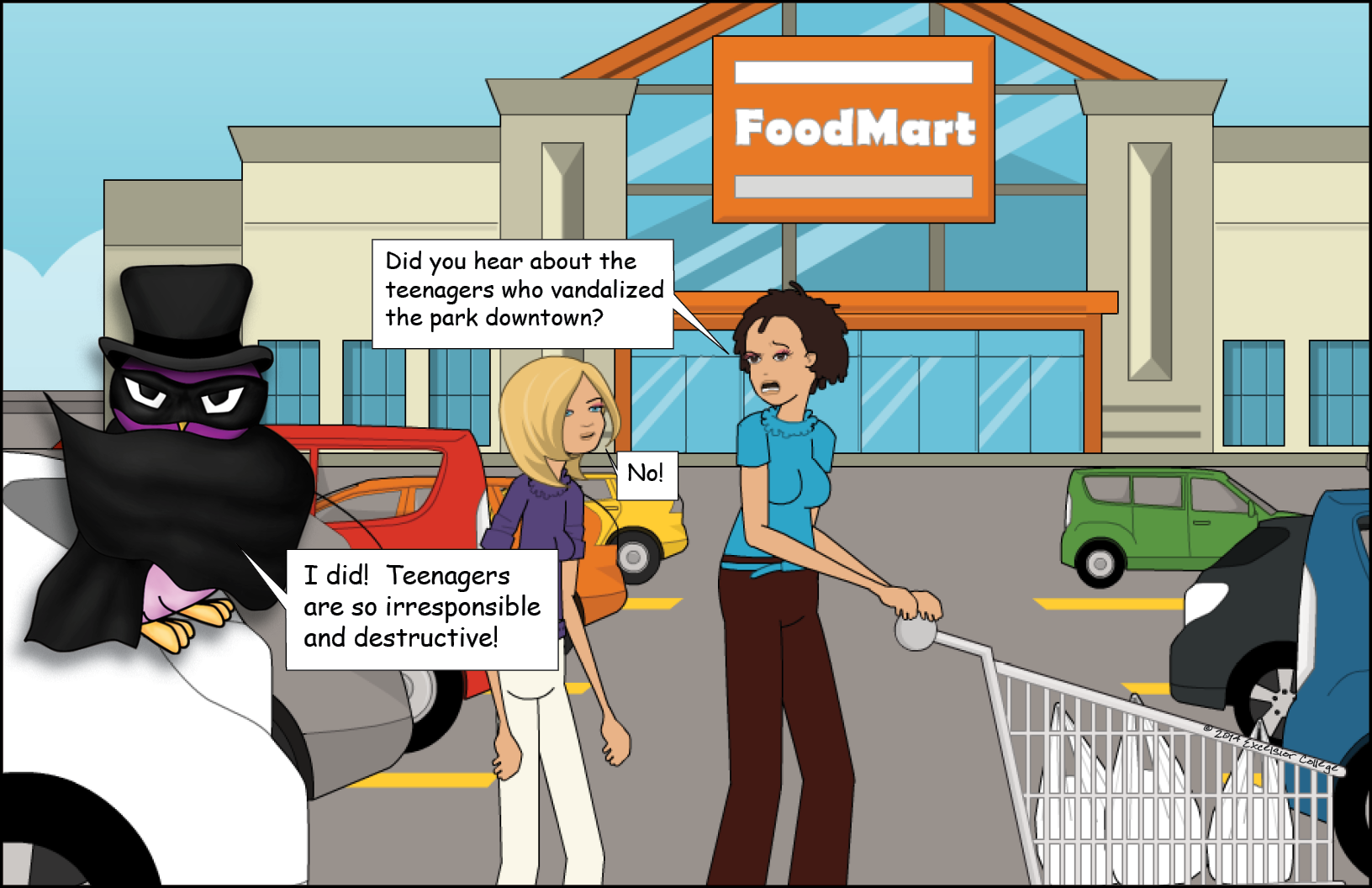
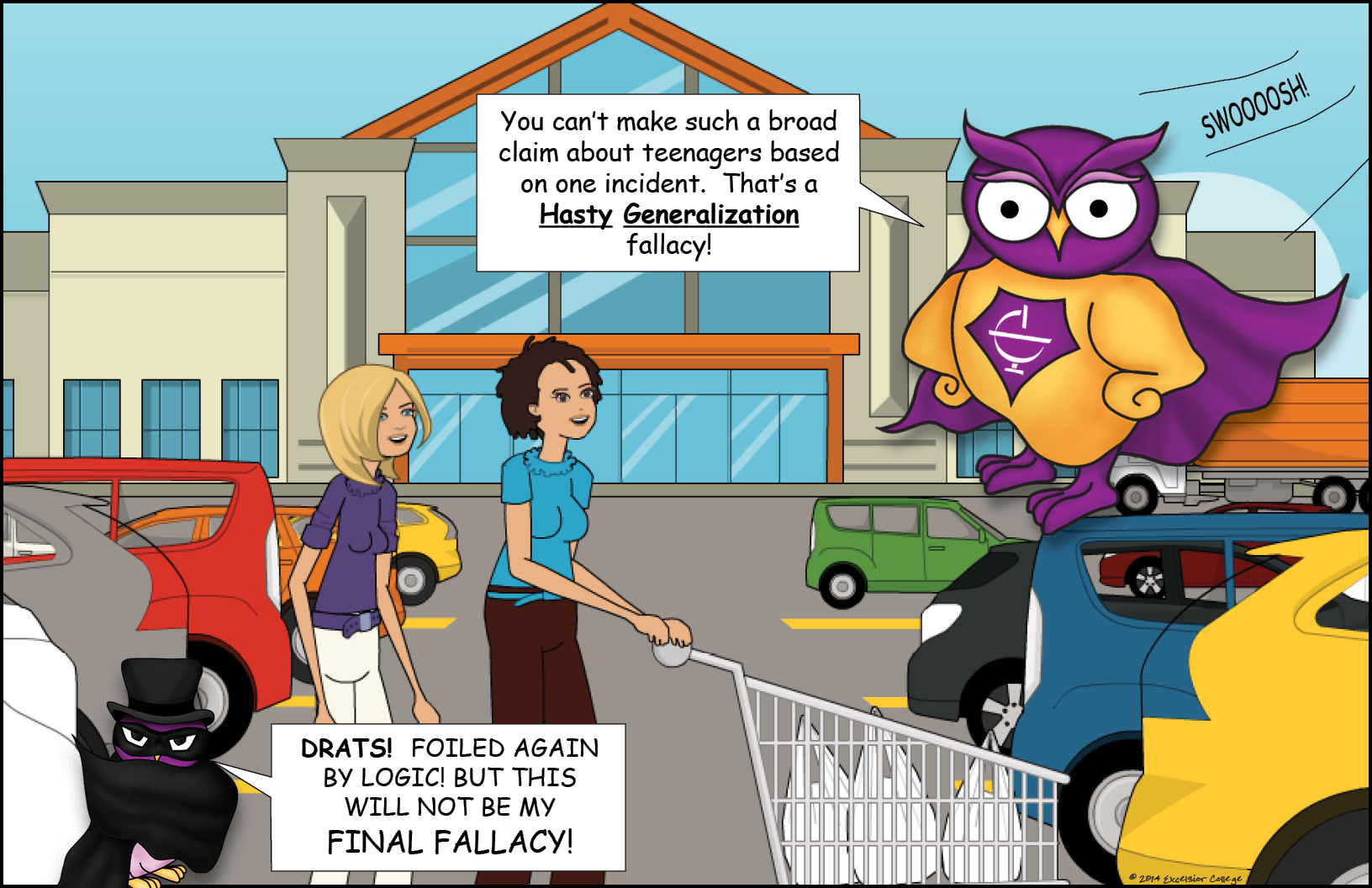
In this example, Dr. Fallacy is making a claim that all teenagers are bad based on the evidence of one incident. Even with the evidence of ten incidences, Dr. Fallacy couldn’t make the claim that all teenagers are problems.
In this instance, the fallacy seems clear, but this kind of fallacious thinking is quite common. People will make claims about all kinds of things based on one or two pieces of evidence, which is not only wrong but can be dangerous. It’s really easy to fall into this kind of thinking, but we must work to avoid it. We must hold ourselves to higher standards when we are making arguments.
Appeal to Fear Fallacy
This type of fallacy is one that, as noted in its name, plays upon people’s fear. In particular, this fallacy presents a scary future if a certain decision is made today.
Example:
Elizabeth Smith doesn’t understand foreign policy. If you elect Elizabeth Smith as
president, we will be attacked by terrorists.
You can see this fallacy in action in Dr. Fallacy’s campaign ad in the comic below.
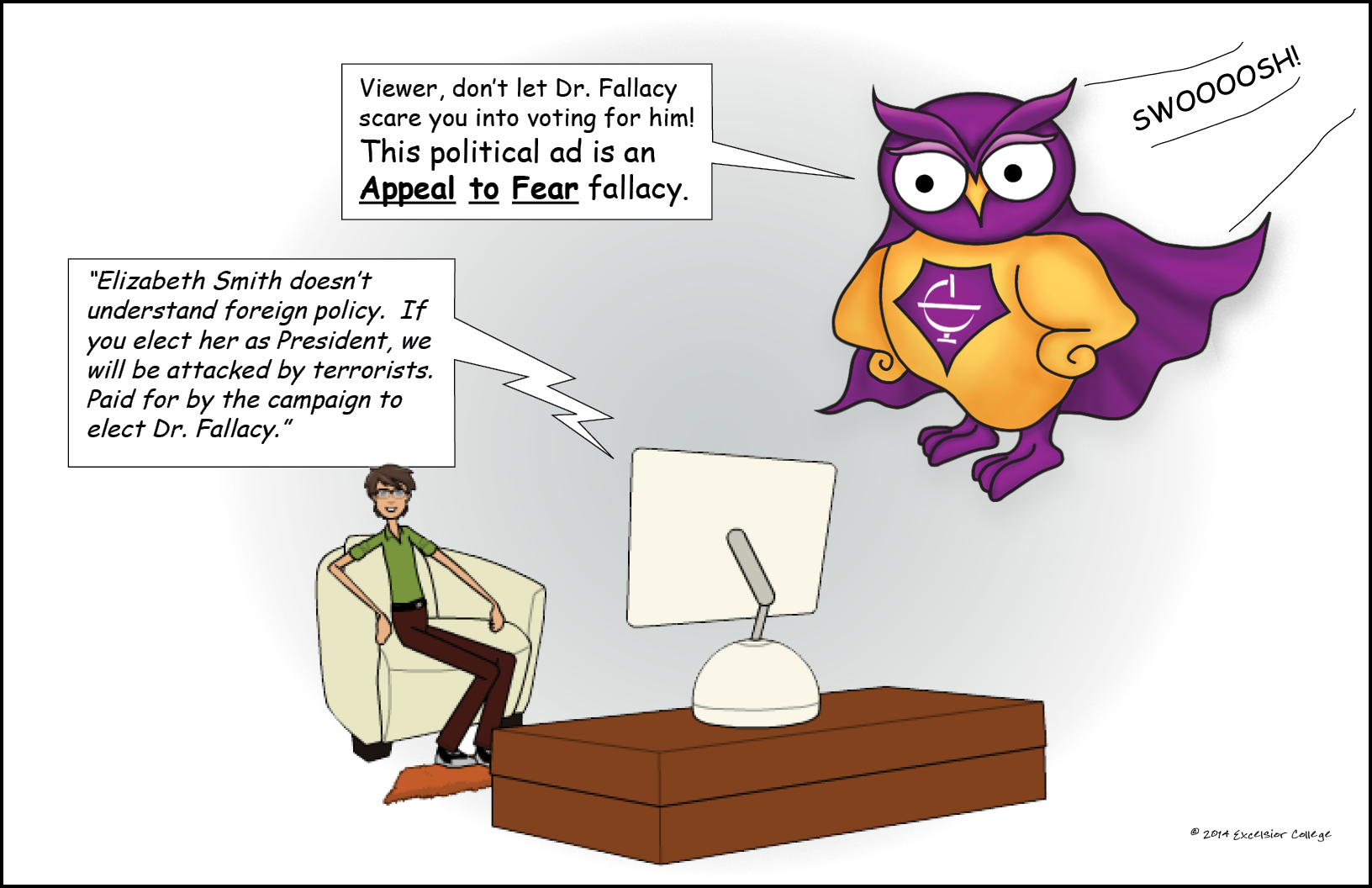
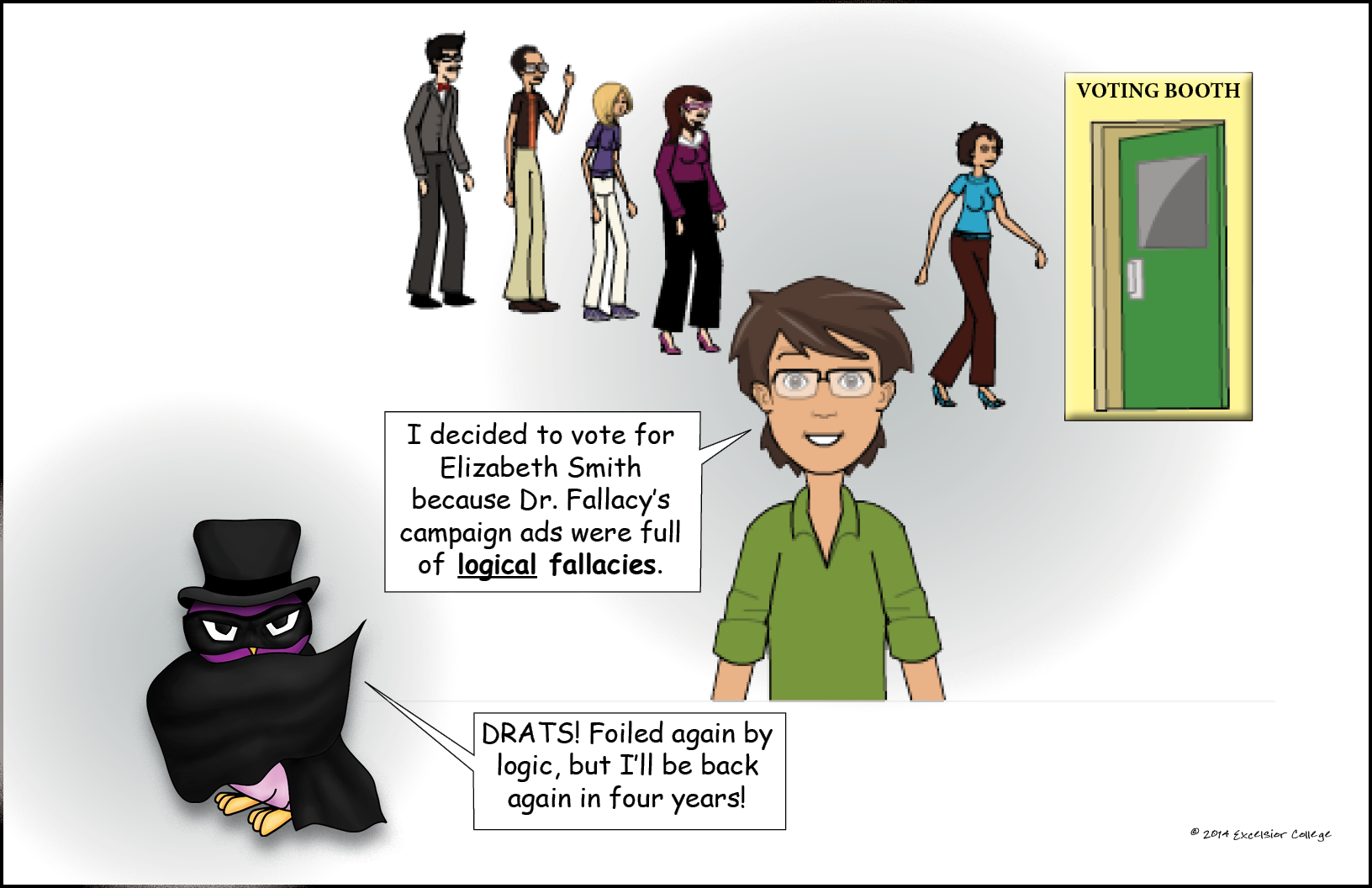
Thankfully, the voters saw through Dr. Fallacy’s faulty logic. While this kind of claim seems outlandish, similar claims have been made by candidates in elections for years. Obviously, this kind of claim isn’t logical, however. No one can predict the future, but making a bold claim like this with no evidence at all is a clear logical fallacy.
Ad Hominem Fallacy
Ad hominem means “against the man,” and this type of fallacy is sometimes called name calling or the personal attack fallacy. This type of fallacy occurs when someone attacks the person instead of attacking his or her argument.
Person 1:
I am for raising the minimum wage in our state.
Person 2:
She is for raising the minimum wage, but she is not smart enough to even run a business.
Check out Dr. Fallacy as he tries to get away with this type of fallacy. Thankfully, Captain Logic OWL saves the day!

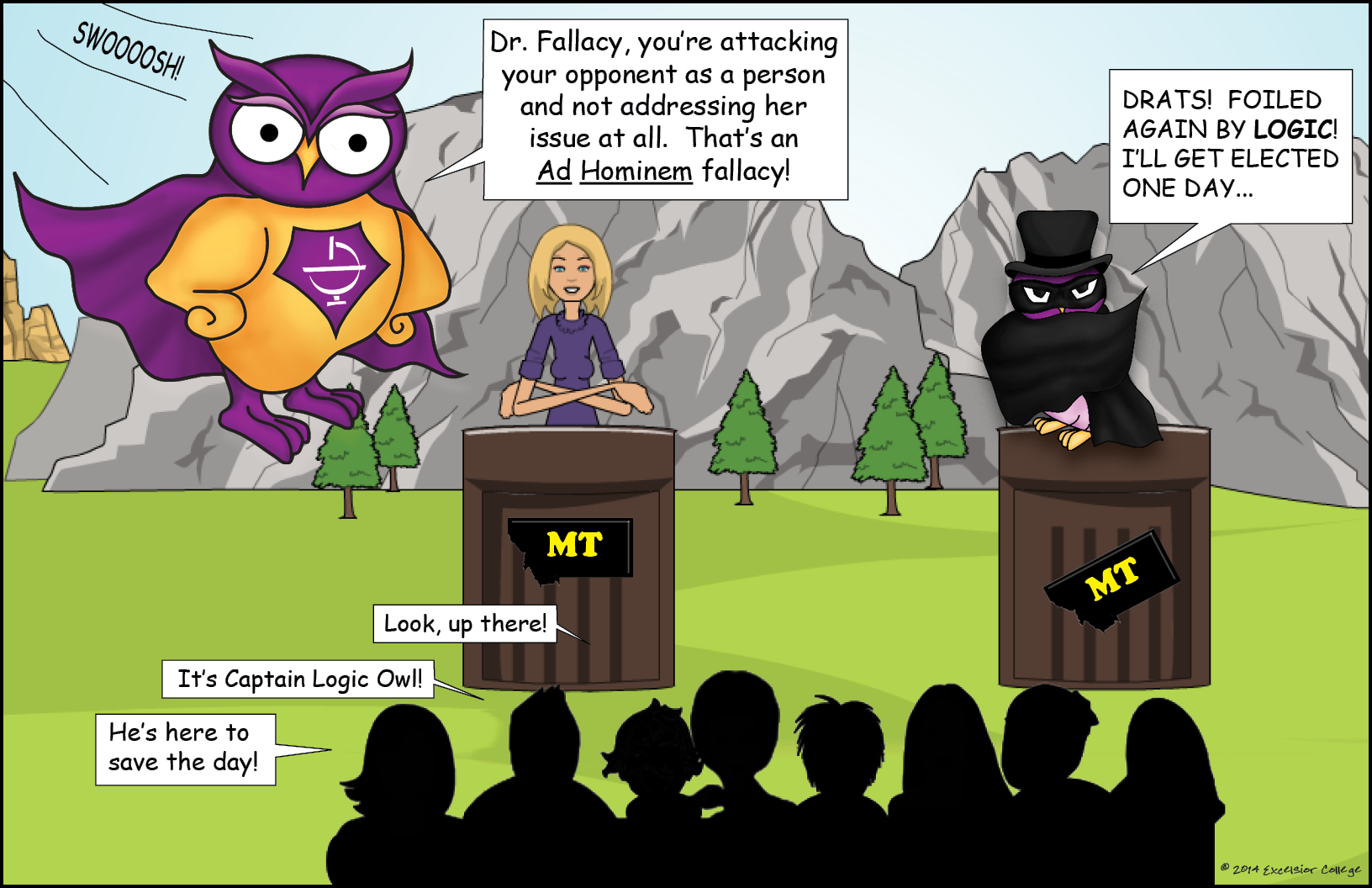
In this example, Dr. Fallacy doesn’t address the issue of minimum wage and, instead, attacks the person. When we attack the person instead of tackling the issue, our audience might think we don’t understand the issue or can’t disprove our opponent’s view. It’s better to stick to the issue at hand and avoid ad hominem fallacies.
Slippery Slope Fallacy
A slippery slope fallacy occurs when someone makes a claim about a series of events that would lead to one major event, usually a bad event. In this fallacy, a person makes a claim that one event leads to another event and so on until we come to some awful conclusion. Along the way, each step or event in the faulty logic becomes more and more improbable.
Example:
If we enact any kind of gun control laws, the next thing you know, we won’t be allowed to have any guns at all. When that happens, we won’t be able to defend ourselves against terrorist attacks, and when that happens terrorists will take over our country. Therefore, gun control laws will cause us to lose our country to terrorists.
See Dr. Fallacy in the comic below try to get away with this fallacy. Fortunately, Captain Logic saves logic and saves the day!
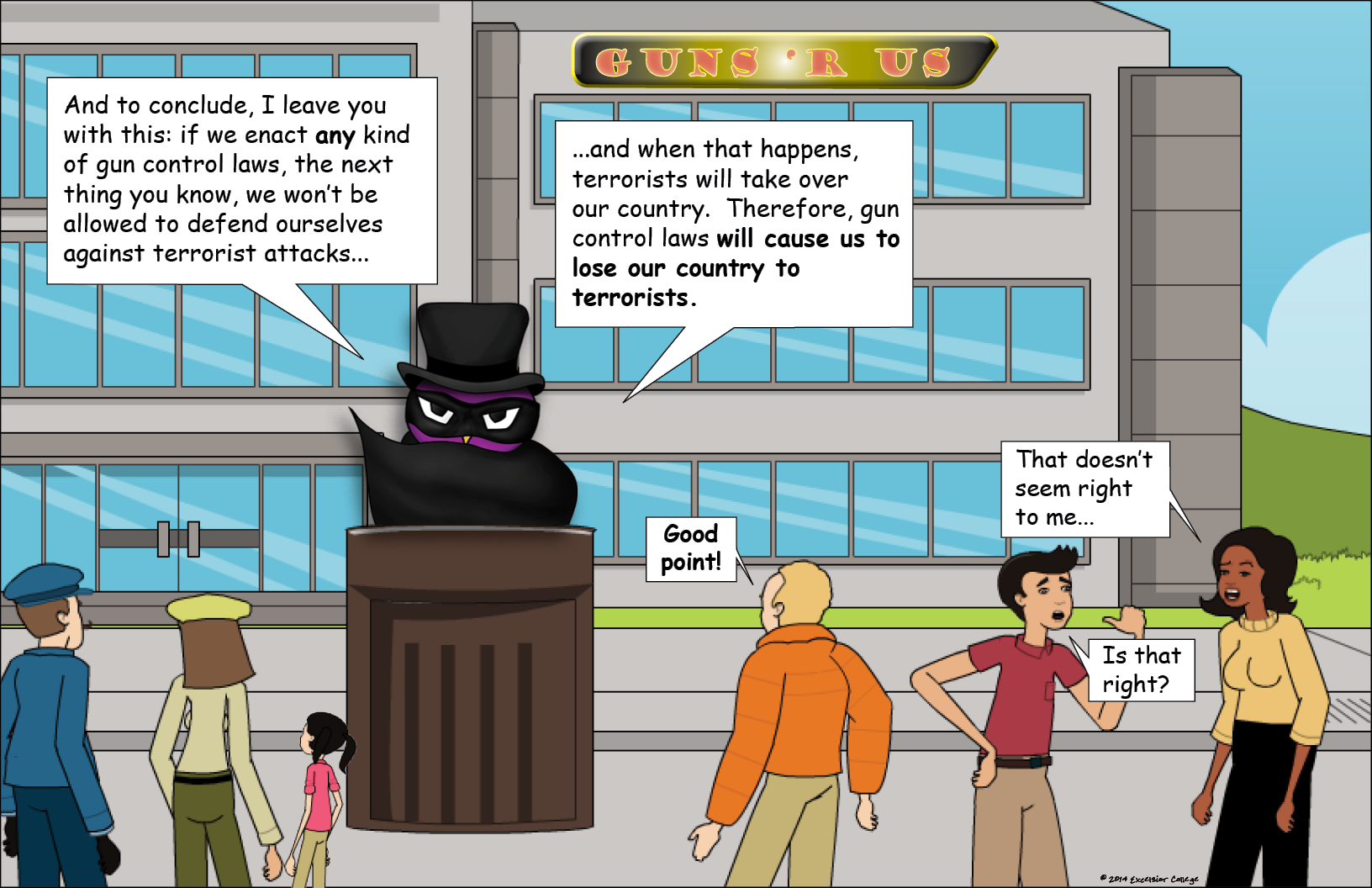
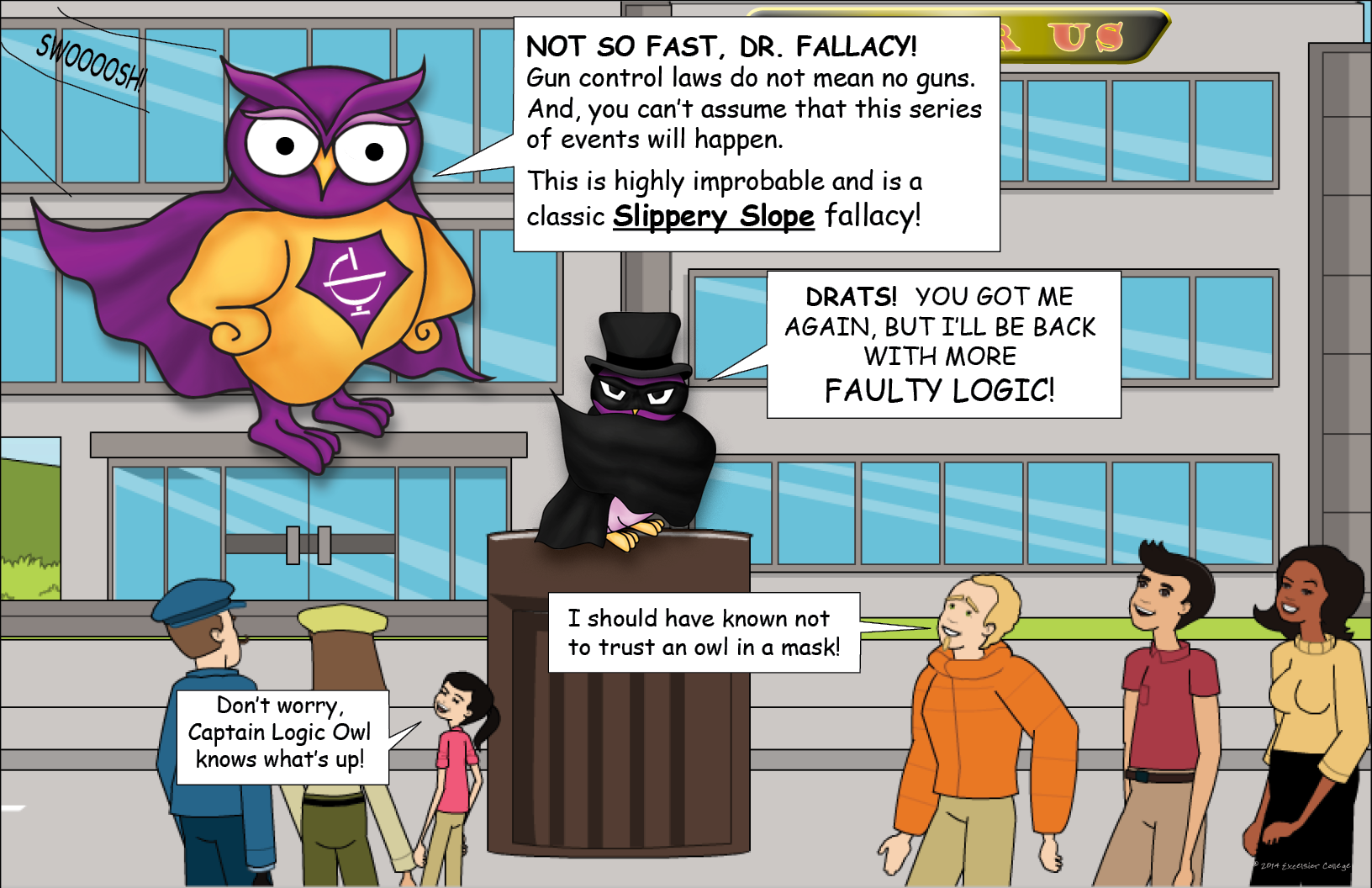
In this example, Dr. Fallacy is following a slippery slope to get to the point that any kind of gun regulation will lead to terrorists taking over the country. The series of events is extremely improbable, and we simply can’t make claims like this and be taken seriously in our arguments.
Of course, this example is extreme, but we do need to make sure, if we are creating a line of reasoning in terms of events leading to other events, that we aren’t falling into a slippery slope fallacy.
Bandwagon Fallacy
The bandwagon fallacy is also sometimes called the appeal to common belief or appeal to the masses because it’s all about getting people to do or think something because “everyone else is doing it” or “everything else thinks this.”
Example:
Everyone is going to get the new smart phone when it comes out this weekend. Why aren’t you?
In the comic below, Dr. Fallacy tries to persuade people using this type of fallacy.
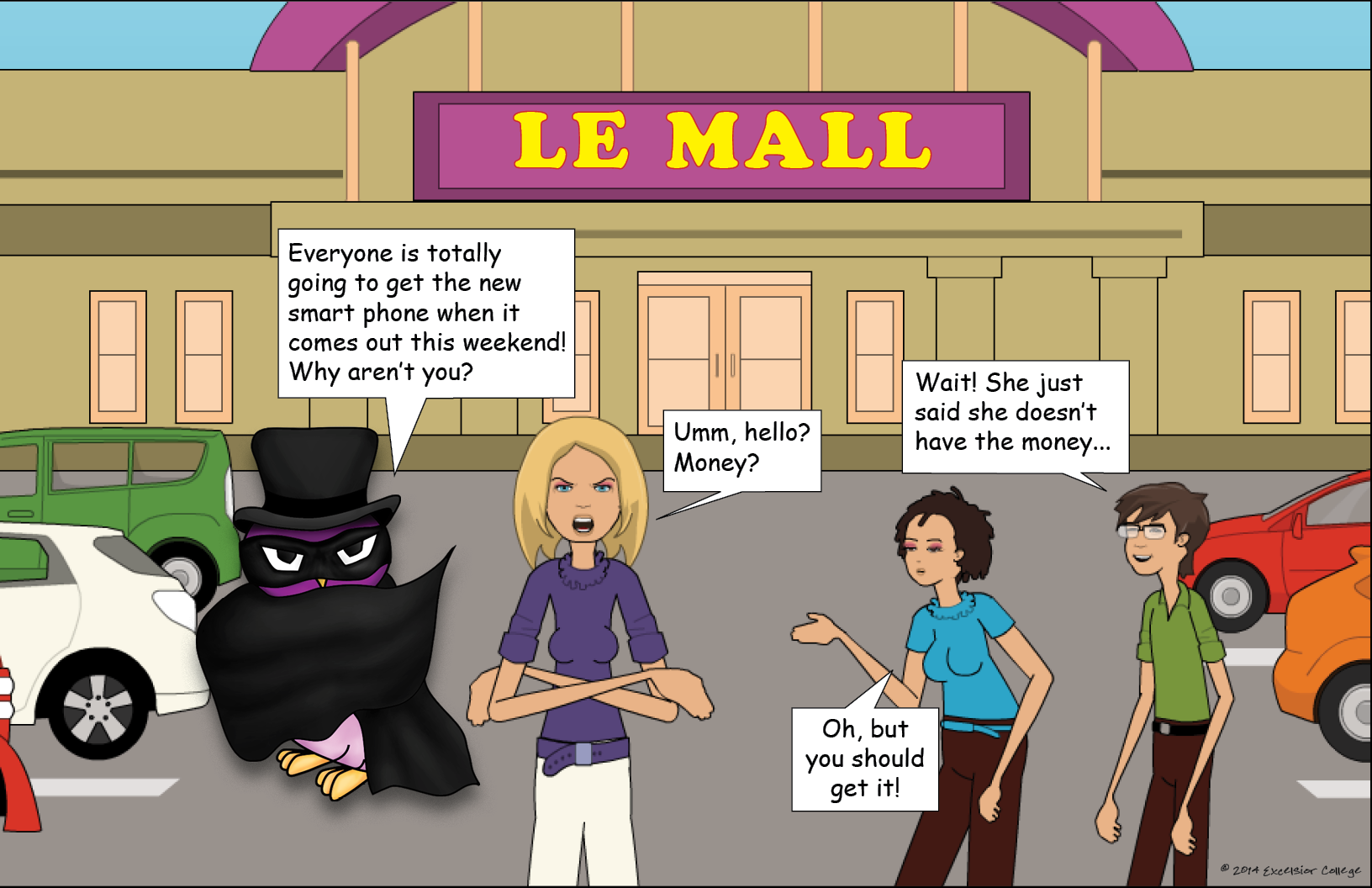
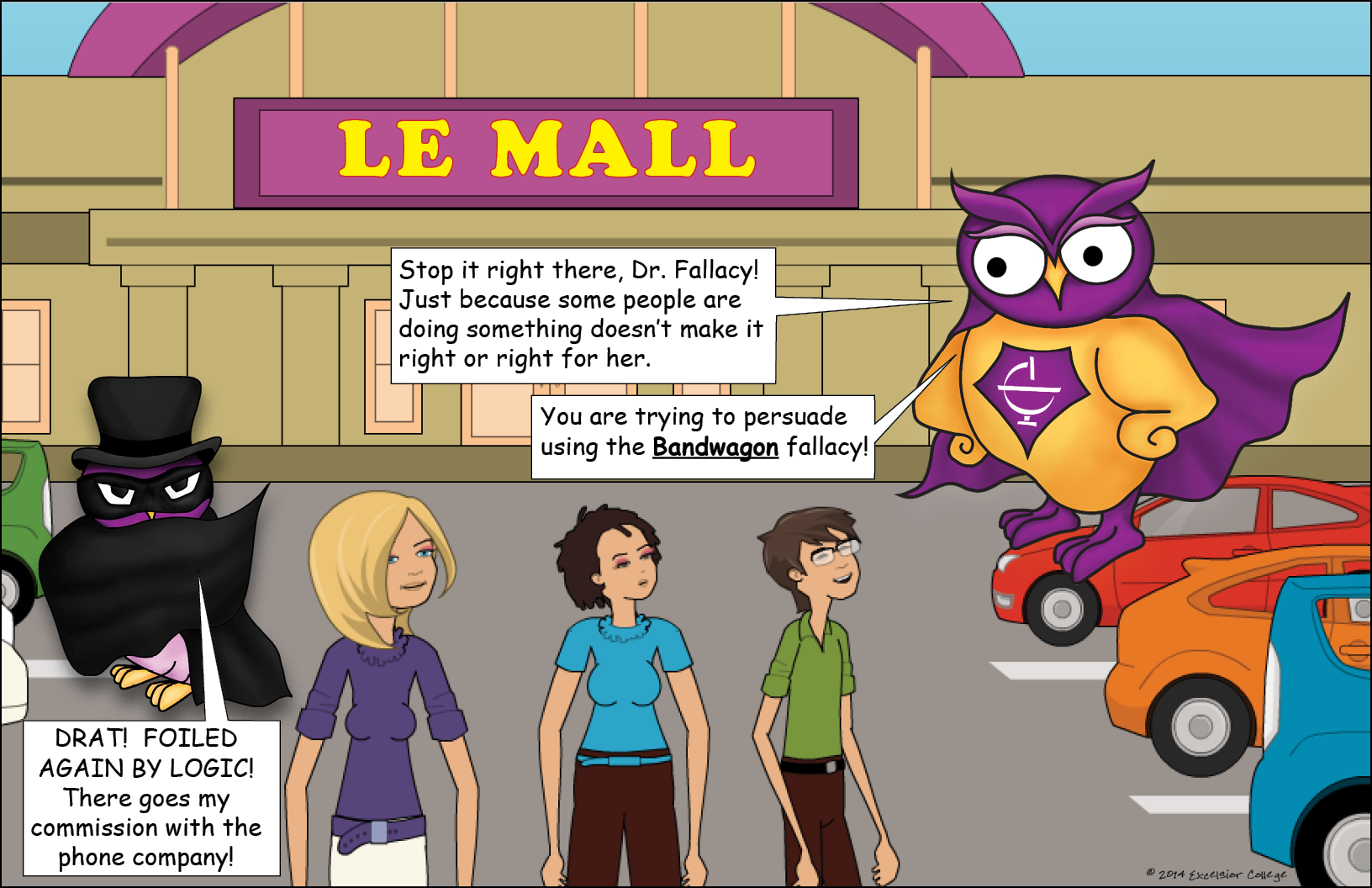
Of course, the problem with this fallacy is not everyone is actually doing this, but there is another problem that’s important to point out. Just because a lot of people think something or do something does not mean it’s right or good to do. For example, in the 16th century, most people believed the earth was the center of the universe; of course, believing that did not make it true.
You want to be careful to avoid this fallacy, as it’s easy to fall into this kind of thinking. Think about what your parents asked you when you insisted that “everyone” was doing something that you were not getting to do: “If everyone of your friends jumped off of a cliff, would you?” It’s important to fight the urge to fall into a bandwagon fallacy.
Guilt by Association Fallacy
A guilt by association fallacy occurs when someone connects an opponent to a demonized group of people or to a bad person in order to discredit his or her argument. The idea is that the person is “guilty” by simply being similar to this “bad” group and, therefore, should not be listened to about anything.
Example:
We cannot have the educational reform that my opponent calls for because Dr. Corrupt has also mentioned this kind of educational reform.
See Dr. Fallacy use this fallacy by associating his opponent with someone named Dr. Corrupt. Clearly, this person isn’t someone to be associated with. Thankfully, Captain Logic OWL points out this flawed logic to the school board.
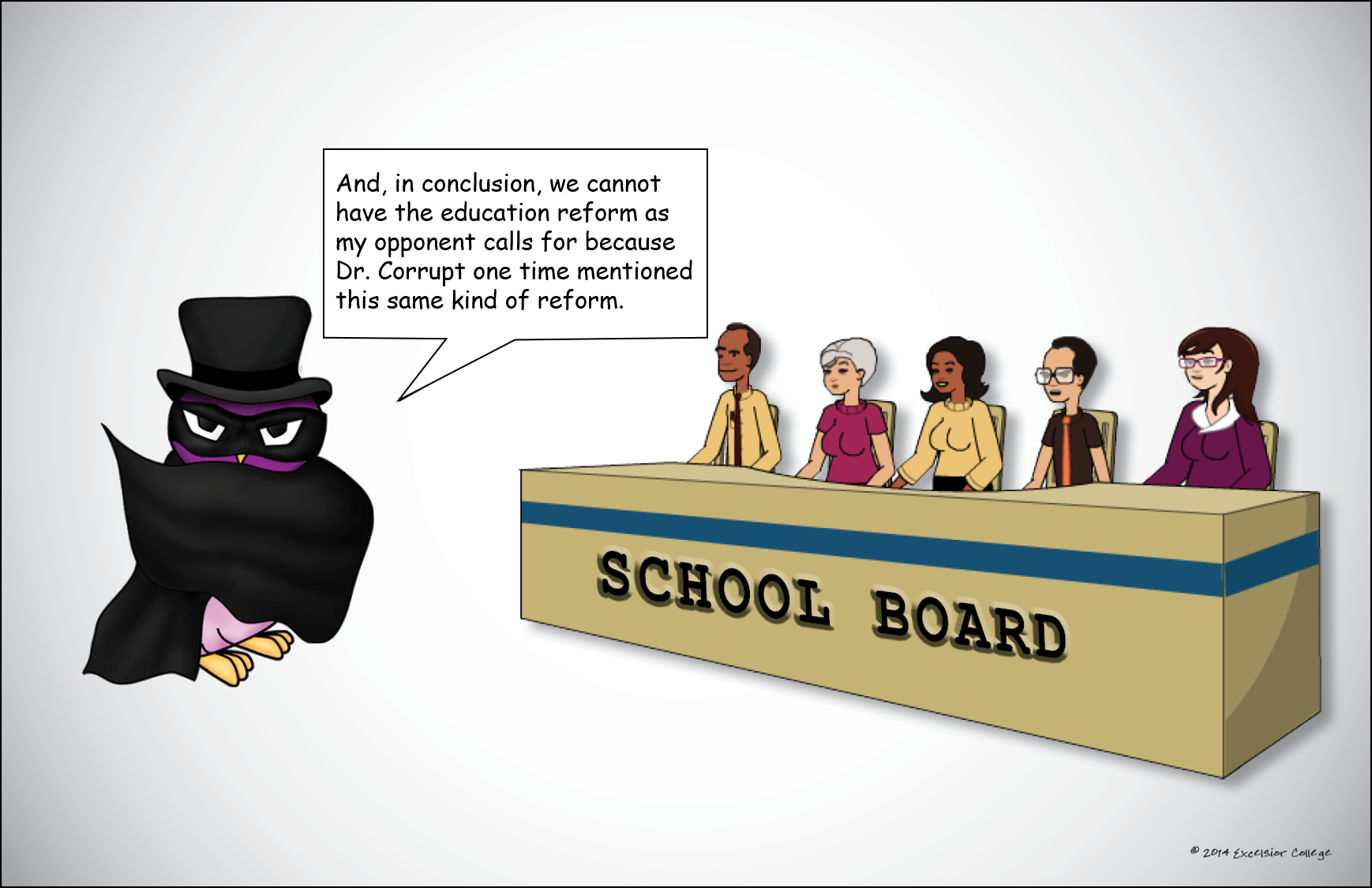
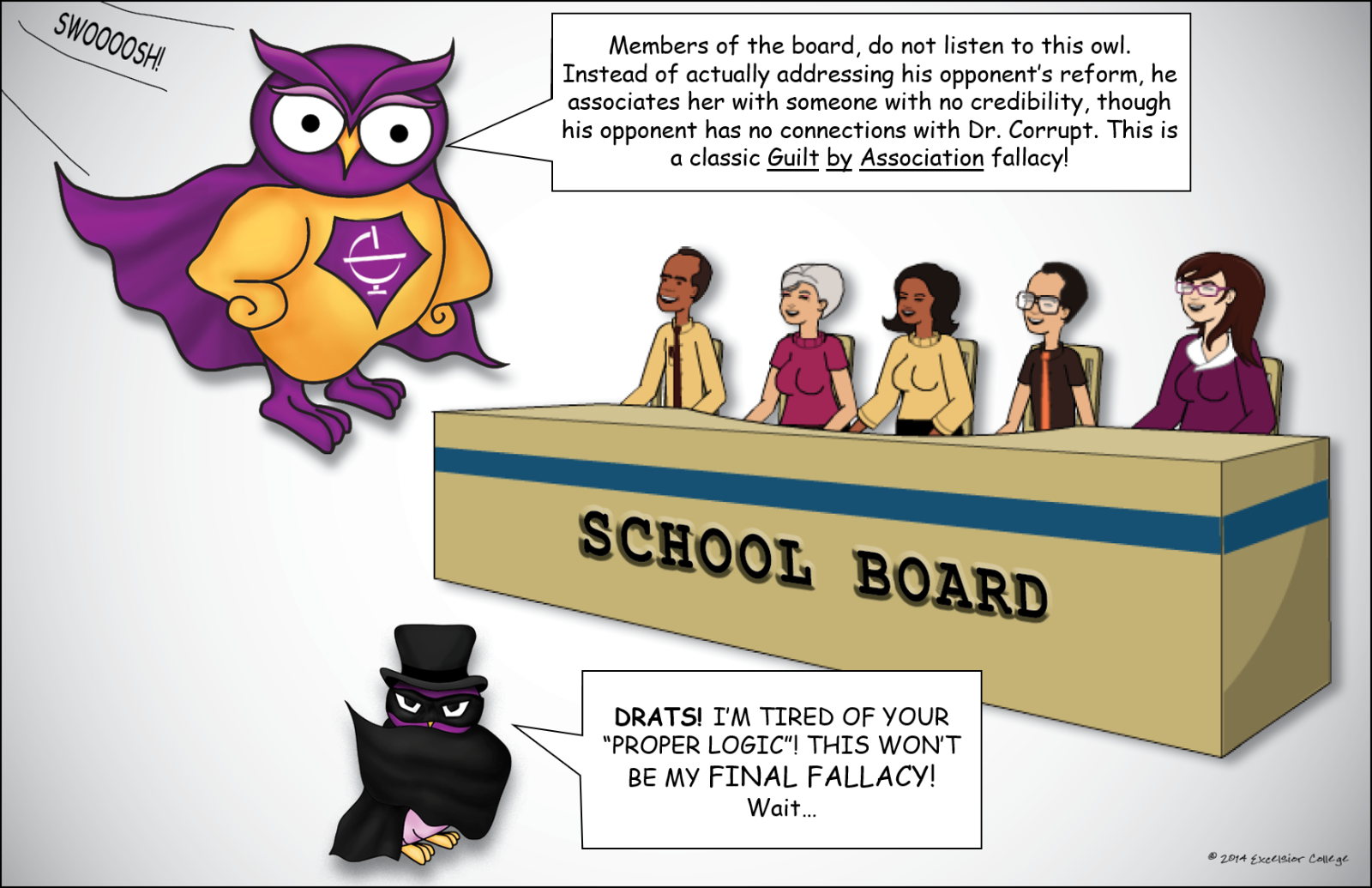
Here, we don’t see what issues Dr. Fallacy has with the educational reform plan, as this isn’t addressed in the fallacy. Instead of dealing with the issue, this person tries to just dismiss the point by connecting his or her opponent’s ideas with the ideas of a person who the audience wouldn’t believe.
This is problematic, of course, because we don’t deal with the issue at hand. Plus, just because “Dr. Corrupt” thinks the same thing or something similar doesn’t mean we should automatically dismiss it. We need to look more closely at the issue at hand, and it seems like the person using this fallacy doesn’t want us to.
Since Dr. Fallacy is once again thwarted by Captain Logic, this may, indeed, be his last fallacy!
Putting It All Together
It’s time to see the fallacies in action! In the videos below, you will see how one student, Mateo, engages in the process of locating sources but struggles to find sources without fallacies. Watch as he applies what he has learned about logical fallacies to his research process. Click on the first video to see Mateo’s assignment and learn about his goals. Then, click on the video that follows in order to see what fallacies Mateo encountered in his sources. When you’re finished, select the activity at the end of this page to see how well you can locate logical fallacies in sources.
Analyze This
This material was developed by Excelsior Online Writing Lab (OWL) and is licensed under a Creative Commons Attribution-4.0 International License. You are free to use, adapt, and/or share this material as long as you properly attribute. Please keep this information on materials you use, adapt, and/or share for attribution purposes.
















